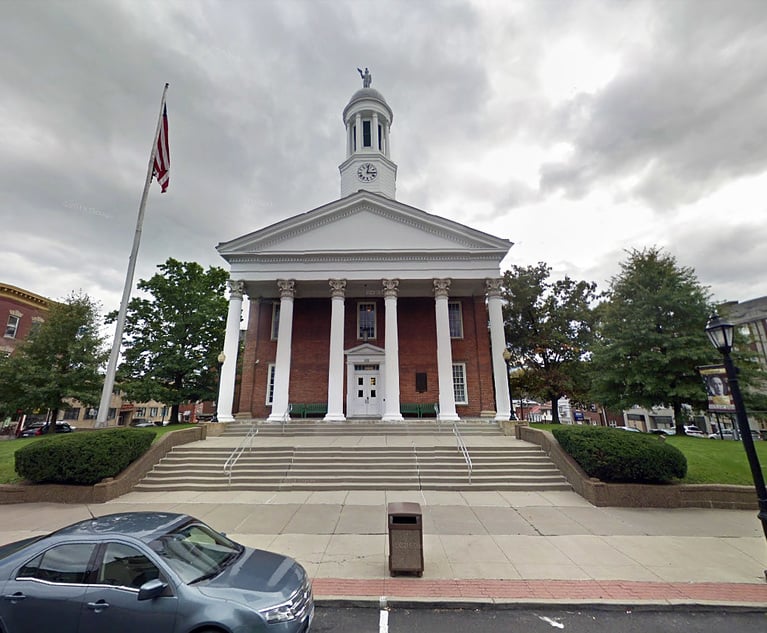Have the Courts Made Room for Inevitability Under the Defend Trade Secrets Act?
The Defend Trade Secrets Act (DTSA), 18 U.S.C. Section 1836, et seq., which was enacted on May 11, 2016, after a Senate vote of 87-0, is the first federal law to protect trade secrets.
November 29, 2018 at 11:54 AM
9 minute read
 Edward T. Kang, left, and Kandis Kovalsky, right, of Kang Haggerty & Fetbroyt.
Edward T. Kang, left, and Kandis Kovalsky, right, of Kang Haggerty & Fetbroyt.
The Defend Trade Secrets Act (DTSA), 18 U.S.C. Section 1836, et seq., which was enacted on May 11, 2016, after a Senate vote of 87-0, is the first federal law to protect trade secrets. The rare unanimous vote was unsurprising given the stunning report by the Commission on the Theft of American Intellectual Property that outlined how theft of intellectual property costs U.S. businesses more than $300 billion a year.
The DTSA highlighted Congress' goal of aligning the federal law closely with the Uniform Trade Secrets Act (UTSA), which has been adopted in some form in almost every state. Just as the Lanham Act, which coexists with state trademark law, the DTSA coexists with state trade secret law. As such, it is important to understand this interplay and what it is likely to look like going forward.
Background of the Inevitable Disclosure Doctrine
Long before the DTSA, there was the inevitable disclosure doctrine, an offshoot of trade secret protection whose roots can be traced back to the early 20th century. See Eastman Kodak v. Powers Film Products, 179 N.Y.S. 325 (N.Y. App. Div. 1919). Under the inevitable disclosure doctrine, an employer can seek an injunction against a former employee to enjoin the employee from working for a competitor if the employer can show the employee could not perform his job for the competitor without inevitably using or disclosing the former employer's trade secrets. The doctrine stands for the principle that once a trade secret has been learned, it cannot be unlearned. The inevitable disclosure doctrine is a powerful legal doctrine as it gives courts the power to enter injunctions even without actual misappropriation.
Pennsylvania first recognized a form of the inevitable disclosure doctrine in 1982, see Air Products & Chemical v. Johnson, 442 A.2d 1114 (Pa. Super. 1982). The court's decision was confusing, as it expressly declined to adopt the inevitable disclosure doctrine while also holding “a person may be enjoined from engaging in employment or certain aspects of his employment where that employment is likely to result in the disclosure of information, held secret by a former employer … .” The court agreed with the trial court's enjoining Richard Johnson from working in certain management positions as it held that it would be “virtually impossible” for him to perform his new job without disclosing trade secrets.
The Pennsylvania Superior Court revisited the inevitable disclosure doctrine, and while it acknowledged the standard it coined only seven years earlier in Air Products (i.e., “virtually impossible”), it set forth a different standard for application of the doctrine where “there is sufficient likelihood or substantial threat” of a defendant disclosing trade secrets. See Den-Tal-EZ v. Siemens Capital, 566 A.2d 1214, 1232 (Pa. Super. 1989). Almost two decades later, the U.S. Court of Appeals for the Third Circuit relied on Air Products rather than Den-Tal-EZ (which, too, analyzed Air Products) to hold that the inevitable disclosure doctrine shall only apply when it is “virtually impossible” for an employee to perform his new job duties without disclosing his former employer's trade secrets, as in Victaulic v. Tieman, 499 F.3d 227 (3d Cir. 2007). The Third Circuit's holding in Victaulic strayed far from that of the Seventh Circuit as outlined in the notable PepsiCo v. Redmond, 54 F.3d 1262 (7th Cir. 1995), one of the most frequently cited cases on the inevitable disclosure doctrine.
In the seminal Bimbo Bakeries case, the Third Circuit attempted to clarify the proper standard for application of the inevitable disclosure doctrine in Pennsylvania in Bimbo Bakeries USA v. Botticella, 613 F.3d 102 (3d Cir. 2010). The Third Circuit reaffirmed that Pennsylvania courts apply the inevitable disclosure doctrine when analyzing threatened misappropriation under 12 Pa.C.S. Section 5303(a). The Third Circuit rejected the “virtually impossible” standard set forth in Victaulic and instead, moved to the other side of PepsiCo by following the “sufficient likelihood or substantial threat” standard outlined in Den-Tal-EZ. The Third Circuit's standard, which remains good law today, is perhaps the most liberal interpretation of the inevitable disclosure doctrine, as even something less than inevitability can support the issuance of an injunction.
The DTSA Was Not Supposed to Encompass the Inevitable Disclosure Doctrine
The DTSA was drafted to prohibit application of the inevitable disclosure doctrine to federal trade secret claims. This is clear from the law's plain language, which permits the court to “grant an injunction … to prevent any actual or threatened misappropriation … provided the order does not … prevent a person from entering into an employment relationship, and that conditions placed on such employment shall be based on evidence of threatened misappropriation and not merely on the information the person knows … .” By requiring evidence of threatened misappropriation, the Senate aimed to preclude application of the inevitable disclosure doctrine under “threatened” misappropriation, as was the case in Bimbo Bakeries.
The history of the DTSA also shows the Senate did not intend for the DTSA to encompass the breadth of the inevitable disclosure doctrine. During the Senate's consideration of the DTSA, California's Sen. Dianne Feinstein, at the last minute, added the provision to the DTSA quoted above. The provision of the DTSA following this one ensures that the law shall not be used as a mechanism to get around state law of those states that have rejected the inevitable disclosure doctrine, namely, California, Louisiana, Maryland and Virginia. This provision, as proposed by Sen. John Cornyn of Texas, that an injunction under the DTSA cannot conflict with an applicable state law prohibiting restraints on the practice of a lawful profession, trade, or business.
As discussed above, the DTSA supplements state law. In states, like Pennsylvania, plaintiffs can still move for an injunction on an inevitable disclosure theory under Pennsylvania state law, specifically the Pennsylvania Uniform Trade Secrets Act (PUTSA), 12 Pa.C.S. Section 5301. In these situations, absent diversity jurisdiction, there is not an automatic pathway to federal court, which is preferable to many, particularly on issues involving trade secrets.
After the DTSA was passed, dozens of lawyers rejoiced in articles over the Senate's resolution of the inevitable disclosure controversy. Their celebration was perhaps premature.
In the last 2 and a half years, have the federal courts interpreted the DTSA as having any room for inevitability? The answer is, yes.
Some Courts Apply (Unnecessarily) the Inevitable Disclosure Doctrine
In an opinion dated May 11, 2017, a federal district court considered the inevitable disclosure doctrine in the context of the DTSA for the first time in Molon Motor & Coil v. Nidec Motor, No. 16-03545, 2017 WL 1954531 (N.D. Ill. May 11, 2017). In Molon, the court allowed a plaintiff to argue the inevitable disclosure doctrine's applicability to defeat a motion to dismiss its claim under the DTSA. In doing so, however, the court emphasized that the plaintiff would ultimately bear the burden of proving, not just alleging, enough facts “such that disclosure is not premised on a mere unsubstantiated fear.” This holding is consistent with the language and purpose of the DTSA, which precludes an injunction, whether preliminary or permanent, without evidence of threatened misappropriation.
In another case out of the Northern District of Illinois (not surprisingly, these cases are from this district, as Illinois has been a longstanding supporter of the inevitable disclosure doctrine), the court granted a plaintiff's motion for a preliminary injunction under both the DTSA and Illinois Trade Secrets Act (ITSA) after finding that the defendant-former employee would inevitably use or disclose the plaintiff's trade secrets, see Mickey's Linen v. Fischer, No. 17-2154, 2017 WL 3970593 (N.D. Ill. Sept. 8, 2017). This is the first inevitable disclosure injunction under the DTSA, and perhaps marks the first divergence from the law's intentions. What is interesting in this case is there was at least circumstantial evidence of misappropriation, meaning it was unnecessary for the court to rule under the inevitable disclosure doctrine. Further, since there were claims under both DTSA and ITSA, the court could have applied the inevitable disclosure doctrine under solely the ITSA to reach the same result while also respecting the intent of the DTSA. Instead, the court has opened the door for inevitability under the DTSA.
The Northern District of Illinois is not alone in this regard. The Third Circuit similarly appeared to recognize the inevitable disclosure doctrine in the context of the DTSA. See Fres-co Systems USA v. Hawkins, 690 Fed.Appx. 72 (3d Cir. 2017). In Fres-co, although the Third Circuit remanded the case to the Eastern District of Pennsylvania, finding it had not addressed all the requisite elements for injunctive relief, it affirmed the trial court's finding of irreparable harm. In doing so, the court, in support of both the DTSA and PUTSA claims, citing to Bimbo Bakeries, appeared to rely on the inevitable disclosure doctrine (albeit not by name) rather than actual evidence (since it could not—there was only oral argument at the trial court) in holding “given the substantial overlap (if not identity) between Kevin Hawkin's work for Fres-co and his intended work for Transcontinental—same role, same industry, and same geographic region—the district court was well within its discretion to conclude Hawkins would likely use his confidential knowledge to Fres-co's detriment.” In the first federal appellate court opinion addressing the DTSA, the Third Circuit seems to have missed an important opportunity to clarify what room there is, if any, under the DTSA for the inevitable disclosure doctrine.
Conclusion
It remains to be seen if the Mickey's Linen and Fres-co holdings are outliers, or if they are merely the beginning of the courts' departure from the express language of the DTSA. So far, neither case has gained traction in being used to expand the DTSA to include the inevitable disclosure doctrine, suggesting they are viewed as isolated one-offs. For now, it seems practitioners can credibly argue both for and against the application of the inevitable disclosure doctrine within the DTSA context.
Edward T. Kang is the managing member of Kang, Haggerty & Fetbroyt. He devotes the majority of his practice to business litigation and other litigation involving business entities. He gave a CLE presentation titled “Emojis Speaking Louder than Words” at the 2018 Annual Meeting of National Association of Minority and Women Owned Law Firms (NAMWOLF) in Chicago, Illinois.
Kandis L. Kovalsky, an associate at the firm, focuses her practice on representing both corporate and individual clients in a broad range of complex commercial litigation matters in Pennsylvania and New Jersey state, federal and bankruptcy courts.
This content has been archived. It is available through our partners, LexisNexis® and Bloomberg Law.
To view this content, please continue to their sites.
Not a Lexis Subscriber?
Subscribe Now
Not a Bloomberg Law Subscriber?
Subscribe Now
NOT FOR REPRINT
© 2025 ALM Global, LLC, All Rights Reserved. Request academic re-use from www.copyright.com. All other uses, submit a request to [email protected]. For more information visit Asset & Logo Licensing.
You Might Like
View All
Superior Court Directs Western Pa. Judge to Recuse From Case Over Business Ties to Defendant
3 minute read
Seven Rules of the Road for Managing Referrals To/From Other Attorneys, Part 2
6 minute read
Litigating the Written Word: Parol Evidence Rule and the Gist of the Action Doctrine in Fraud Claims
6 minute read
Trending Stories
- 1Pa. High Court: Concrete Proof Not Needed to Weigh Grounds for Preliminary Injunction Order
- 2'Something Else Is Coming': DOGE Established, but With Limited Scope
- 3Polsinelli Picks Up Corporate Health Care Partner From Greenberg Traurig in LA
- 4Kirkland Lands in Phila., but Rate Pressure May Limit the High-Flying Firm's Growth Prospects
- 5Davis Wright Tremaine Turns to Gen AI To Teach Its Associates Legal Writing
Who Got The Work
J. Brugh Lower of Gibbons has entered an appearance for industrial equipment supplier Devco Corporation in a pending trademark infringement lawsuit. The suit, accusing the defendant of selling knock-off Graco products, was filed Dec. 18 in New Jersey District Court by Rivkin Radler on behalf of Graco Inc. and Graco Minnesota. The case, assigned to U.S. District Judge Zahid N. Quraishi, is 3:24-cv-11294, Graco Inc. et al v. Devco Corporation.
Who Got The Work
Rebecca Maller-Stein and Kent A. Yalowitz of Arnold & Porter Kaye Scholer have entered their appearances for Hanaco Venture Capital and its executives, Lior Prosor and David Frankel, in a pending securities lawsuit. The action, filed on Dec. 24 in New York Southern District Court by Zell, Aron & Co. on behalf of Goldeneye Advisors, accuses the defendants of negligently and fraudulently managing the plaintiff's $1 million investment. The case, assigned to U.S. District Judge Vernon S. Broderick, is 1:24-cv-09918, Goldeneye Advisors, LLC v. Hanaco Venture Capital, Ltd. et al.
Who Got The Work
Attorneys from A&O Shearman has stepped in as defense counsel for Toronto-Dominion Bank and other defendants in a pending securities class action. The suit, filed Dec. 11 in New York Southern District Court by Bleichmar Fonti & Auld, accuses the defendants of concealing the bank's 'pervasive' deficiencies in regards to its compliance with the Bank Secrecy Act and the quality of its anti-money laundering controls. The case, assigned to U.S. District Judge Arun Subramanian, is 1:24-cv-09445, Gonzalez v. The Toronto-Dominion Bank et al.
Who Got The Work
Crown Castle International, a Pennsylvania company providing shared communications infrastructure, has turned to Luke D. Wolf of Gordon Rees Scully Mansukhani to fend off a pending breach-of-contract lawsuit. The court action, filed Nov. 25 in Michigan Eastern District Court by Hooper Hathaway PC on behalf of The Town Residences LLC, accuses Crown Castle of failing to transfer approximately $30,000 in utility payments from T-Mobile in breach of a roof-top lease and assignment agreement. The case, assigned to U.S. District Judge Susan K. Declercq, is 2:24-cv-13131, The Town Residences LLC v. T-Mobile US, Inc. et al.
Who Got The Work
Wilfred P. Coronato and Daniel M. Schwartz of McCarter & English have stepped in as defense counsel to Electrolux Home Products Inc. in a pending product liability lawsuit. The court action, filed Nov. 26 in New York Eastern District Court by Poulos Lopiccolo PC and Nagel Rice LLP on behalf of David Stern, alleges that the defendant's refrigerators’ drawers and shelving repeatedly break and fall apart within months after purchase. The case, assigned to U.S. District Judge Joan M. Azrack, is 2:24-cv-08204, Stern v. Electrolux Home Products, Inc.
Featured Firms
Law Offices of Gary Martin Hays & Associates, P.C.
(470) 294-1674
Law Offices of Mark E. Salomone
(857) 444-6468
Smith & Hassler
(713) 739-1250





